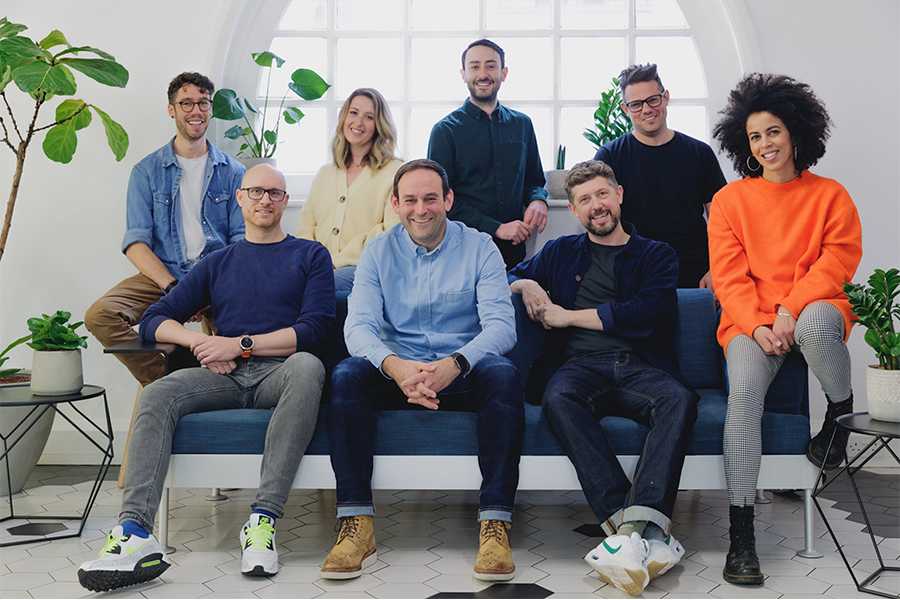Powered by possibility
Image courtesy of Wonder | Amplify-x-Wonder
by Jade French
Wonder is an independent creative agency specialising in B2B (business-to-business) and B2E (business-to-employee) experiences. As an agency, they put people first to make sure that companies don’t lose sight of the people who make their brands deliver. The agency has breathed new life into B2B and B2E, delivering memorable experiences for clients including Google, Vodafone, Adobe and Canva. Their recent partnership with Amplify, a global brand experience agency, emphasises the importance of B2B and B2E in the new marketing landscape, as brands realise that creative thinking and bold storytelling can exist beyond consumer-facing needs.
As the world of work shape-shifts, agencies like Wonder are constantly innovating and keeping up-to-date to make sure that a work/life balance reflects the complex ways businesses talk to one another and their employees. For Wonder, it’s about putting the audience at the heart of what they do—whether that’s building a whole village across 50,000sqm of London’s ExCeL conference centre for Google, or creating a home-inspired hybrid residency for 18,000 of Vodafone’s global workforce.
To find out more about how conferences, summits, events and meetings can take a more innovative approach, ALHAUS spoke to Wonder Strategy Director Jonathan Izzard about how to centre the right audience, create compelling stories and face a new normal.
Image courtesy of Wonder | Google Cloud, Google's largest event in EMEA
First of all, tell us a bit about Wonder and your approach to B2B/B2E events.
Wonder is a full-service B2B experience agency, working across every B2B experience touchpoint from product launches to exhibitions, employee engagement to conferences and logo-to-live brand worlds, spanning virtual, hybrid and IRL platforms. We exist to create the next generation of experiences for businesses and their audiences. We describe the work we do within B2B/B2E as being ‘powered by possibility’—optimistic, curious and bold.
What does taking an ‘audience first’ approach mean to you?
One of our core values is helping businesses build experiences that can better connect with the people that matter to them. We don’t think about delegates, customers, attendees, employees, stakeholders or shareholders, but people. We build more human experiences, and taking a people-first approach through smart strategic thinking and insights is vital to this vision.
People-first means building events and experiences that are meaningful in the face of shifting expectations and evolving mindsets. People-first experiences are not only more appealing to attend, and more engaging in the moment, but they are more likely to encourage tangible action in the wake of an event.
We talk about events built for people’s ‘whole selves’; mindful of the inescapable merging over the past two years of work and home lives, what we do needs to reflect a less binary business existence and B2B experience. For us, in practical terms, this means that with any brief, interrogation of the event audience is the first and most crucial step.
The pandemic has shifted approaches to both work and play, joining remoteness and connection hand-in-hand forever more. How do hybrid events help bridge the gap between these two feelings?
The concept of ‘hybrid’ is nothing new. From FIFA World Cup Finals to Saturday night at Glastonbury, remote connections with live moments that matter is commonplace. In the context of our industry, ‘hybrid’ is, perhaps, the best means of expressing the smoother and more meaningful interaction between real and virtual worlds.
For us, the ‘hybrid’ is simply a description of the process of blending perfect experiences. Understanding who our audiences are, where they are and what they want — and building the most engaging and appropriate experiences to meet their relative needs. URL will never replace IRL, but in some instances it can have advantages over it. Our job is to bottle the value of each and deliver this to our audiences, wherever they are.
Image courtesy of Wonder | BT, The Power of Change
Conferences, summits and exhibitions are all about inspiration and education. What are your top tips for creating a curiosity-driven environment at these events?
B2B events need to engage a diverse range of personalities and people across a business and its customer base. Building experiences around the post-pandemic intersection of work and life allows us to engage attendees progressively, as their whole selves. We do this by defining a set of experience principles designed to engage, educate and entertain, meeting both business and human needs.
This means experiences that don’t just deliver insights but enable personal discovery—not just facilitating networking, but creating moments of togetherness. Experiences should provide not just value, but meaning.
This can play out in a number of ways: rethinking traditional format constraints such as venue, keynote or roundtables; embracing more ‘open-source creativity’, bringing to bear influences from beyond business to engage and inspire audiences; and connecting with attendees via strategic storytelling; and weaving a compelling narrative into the experience they have and the messages we give.
How important is storytelling to your branding and marketing strategies?
Throughout the pandemic, content of all shapes and sizes fuelled, revived, nourished and informed us. Lockdown living was made more bearable by on-demand programming, flexing to meet our often complex needs. While terrestrial television still plays a big role in households, the universality of streaming and the proliferation of access points to high-quality, non-linear content changed our relationship with it and our expectations of it.
Whether through a more traditional medium or one of the new kids on the block, one of the key components of content is its ability to tell a story. Compelling narrative arcs deepen our emotional attachment to a moment, a product, or a relationship. For B2B experiences, consideration of the ebb and flow of the ‘story’ being told, its timing and the mediums through which to express it are all key to delivering content that is both engaging and effective.
For Wonder, this means non-linear, people-focused content design, human storytelling through human experiences, and a healthy mix of both personal and communal moments, stimulating both introspection and interaction.



